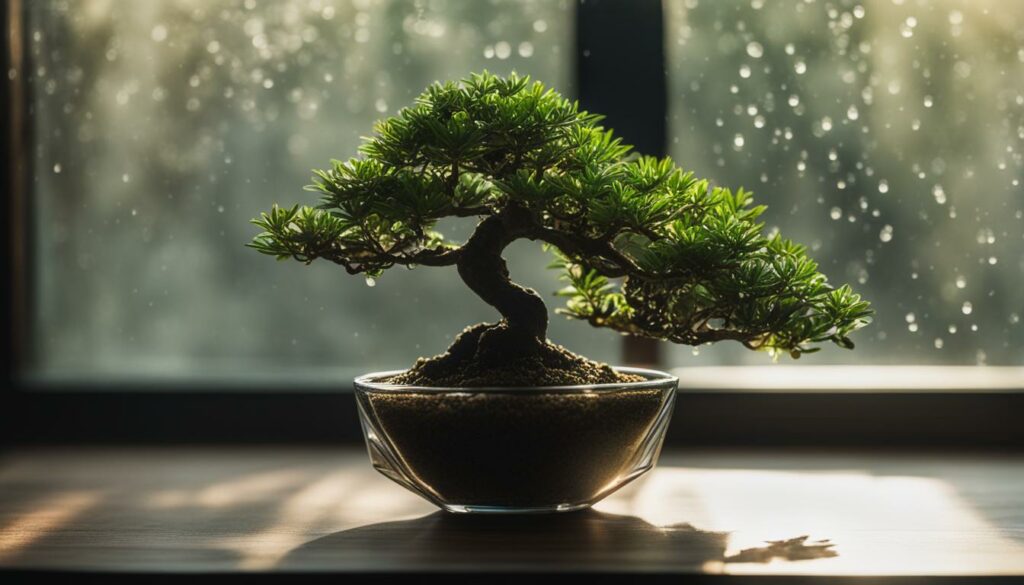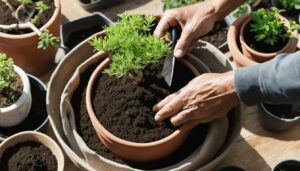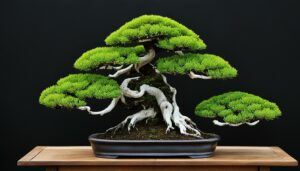Are you looking to take your bonsai cultivation to the next level? Creating microclimates could be the key to unlocking robust growth for your trees. Microclimates are small-scale environmental zones that differ from the surrounding area and can be customized to meet the unique needs of your bonsai. By tailoring temperature, humidity, light levels, and airflow to suit your trees, you can optimize their growth and health.
In this article, we’ll explore how microclimates can give your bonsai the ideal growing conditions, provide tips on creating microclimates that adapt to different growing zones, and share troubleshooting advice for typical microclimate challenges.
Key Takeaways:
- Creating microclimates involves customizing the environment to meet your bonsai’s needs.
- Factors such as temperature, humidity, light levels, airflow, and protection from harsh weather can be adjusted to create an optimal growing environment
- Different bonsai species require different microclimates due to their varying preferences and requirements.
- Regular monitoring and adjustment of microclimates can help ensure robust growth for your bonsai.
- Troubleshooting microclimate challenges such as heat stress and humidity imbalances is an important aspect of bonsai cultivation.
Understanding Microclimates
Creating microclimates is an essential aspect of optimizing bonsai cultivation. Microclimates are small areas within a garden or greenhouse that have their own unique set of environmental conditions, such as temperature, humidity, light, and airflow. They allow you to tailor the growing conditions for your bonsai trees, ensuring they receive the ideal balance of environmental factors that promote healthy growth and development.
Environmental control is key to creating microclimates. By adjusting the variables within a microclimate, such as temperature and humidity, you can create conditions that are tailored to the specific needs of your bonsai trees.
The role of microclimates in bonsai cultivation cannot be overstated. They enable you to adapt your growing environment to different bonsai species and growing zones, giving you greater control over the variables that affect your trees’ growth.
The Importance of Environmental Control
Environmental control enables you to optimally manage the conditions within your microclimates. It involves regulating temperature, light, humidity, and airflow to meet your bonsai trees’ specific needs.
For example, some bonsai species require cooler temperatures to thrive, while others prefer warmer environments. By creating microclimates with the appropriate temperature settings, you can ensure your bonsai trees grow strong and healthy.
Similarly, some bonsai species require higher humidity levels, while others require lower humidity levels. By using microclimates with the right humidity settings, you can create the ideal growing conditions for your trees.
The Benefits of Microclimates
Maintaining microclimates provides a range of benefits for bonsai cultivation.
One of the most significant benefits of microclimates is the ability to extend the growing season for your trees. By creating the optimal growing conditions within a microclimate, you can enable your bonsai trees to grow for longer periods throughout the year.
Microclimates also enable you to protect your bonsai trees from harsh weather conditions. By creating microclimates with protective barriers and shelters, you can shield your trees from excessive sun exposure, wind, and frost.
Overall, understanding microclimates and their role in bonsai cultivation is essential to achieving optimal growth and success in your bonsai collection.
Assessing Your Bonsai’s Needs
As mentioned earlier, each bonsai species has its unique preferences and requirements for temperature, light, humidity, and airflow. Therefore, before creating a microclimate, you need to assess your bonsai’s needs based on its species, growing zones, and overall health.
To evaluate your bonsai’s growing zone, you must determine your area’s USDA plant hardiness zone. The hardiness zone map divides the United States into 13 zones, based on the lowest annual temperature. By knowing your zone, you can identify which bonsai species are suitable for your area and select the best microclimate strategies.
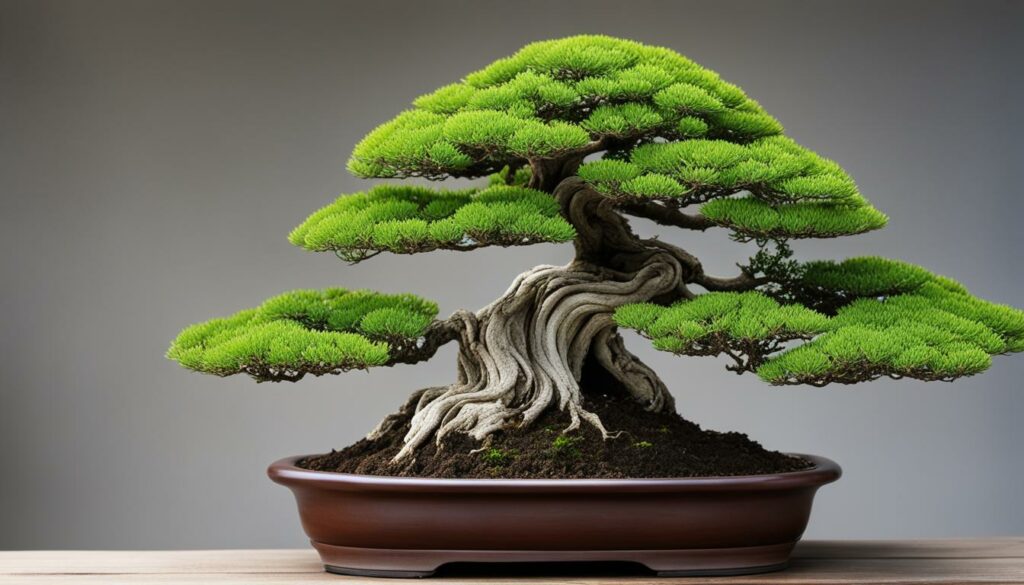
In addition to the zone, you should consider other bonsai adaptations. For instance, some bonsai species thrive in the full sun, while others require partial or full shade. You should also keep in mind your bonsai’s health status, as sick trees may have different requirements.
After assessing your bonsai’s needs, you can determine the optimal temperature, humidity, and light levels for your microclimate. In the next section, we’ll discuss how to use this information to select the right location for your bonsai.
Choosing the Right Location
The location where you place your bonsai can significantly impact the success of your cultivation efforts. It plays a crucial role in creating the ideal microclimate for your plants. Take into account several factors when selecting a location that promotes healthy bonsai cultivation.
Sunlight Exposure
Bonsai trees require a specific amount of sunlight, which varies by species. Some require full sun exposure, while others prefer partial shade. Check the growing zone recommendations for your specific species and ensure that your chosen location matches the recommended sunlight exposure. Also, try to avoid locations where strong winds and direct sunlight could cause heat stress to your bonsai.
Wind Protection
Bonsai trees must be sheltered from strong winds that can dry out their foliage and promote disease. An excellent way to control wind exposure is to place your bonsai in a location that offers natural barriers. For instance, by planting near buildings, tall shrubs or ornamental grasses. You can even create a wind barrier with artificial items such as shade sails or sheer barriers.
Proximity to Buildings or Natural Barriers
Another option for protecting your bonsai from tough winds is to place them close to a wall that can deflect the wind. Walls and fences can also help safeguard against pests and provide partial shade. If you don’t have a suitable wall, you can use a trellis, hedging, or tall ornamental grass as a natural barrier to protect your bonsai from pests, wind, or too much sunlight.
Proper location ensures a favorable microclimate for your bonsai, helping them to thrive and grow healthily. Taking the time to assess and find the right place around your home will go a long way in protecting your tree.
Controlling Temperature
Temperature control is a key factor in creating microclimates for your bonsai trees. Temperature affects your trees’ health, productivity, and overall growth. By regulating temperature according to their unique needs, you can prevent heat stress, frost damage, and other temperature-related problems.
One way to control temperature is to use shade cloth. Shade cloth protects your trees from excessive sunlight and reduces heat radiation, helping to maintain a cooler temperature. You can also use fans or misting systems to regulate temperature and airflow in your microclimate.
| Temperature Tips: |
|---|
| Use heat mats in colder climates to provide bottom heat to your bonsai pots |
| Place your bonsai in an area with morning sun and afternoon shade, especially in hot regions |
| Consider using portable air conditioning units or heaters to maintain optimal temperature in extreme weather conditions |
It’s crucial to monitor your microclimate’s temperature regularly and adjust it accordingly. Bonsai temperature needs will depend on their species, growing zone, and time of year. For example, in hot weather, you may need to increase shade or access to water, while in colder weather, you may need to provide more insulation or protection from frost.
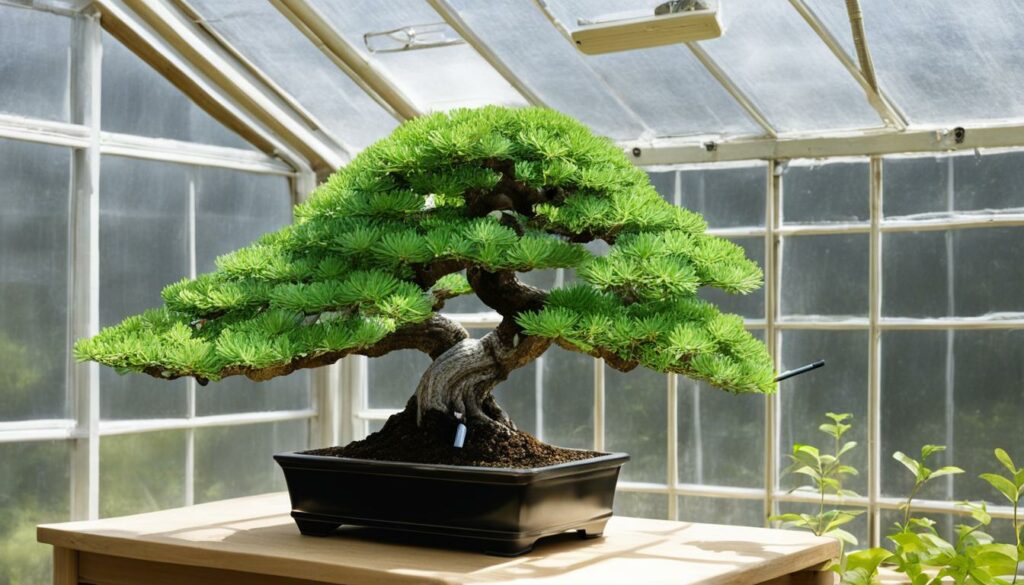
Managing Light Levels
Light is one of the most important factors in bonsai cultivation as it greatly affects your tree’s growth, flowering, and overall health. Creating the right amount of light for your bonsai is essential in maintaining optimal microclimates and can be achieved through shading, artificial lighting, and positioning within your garden.
Shading
Shading is a technique used in creating microclimates that provides a barrier between your bonsai and the harsh midday sun. Shade cloth or umbrellas can be used to reduce direct and indirect sunlight while still allowing filtered light to pass through. When creating shade, it is important to remember that too much shade can hinder growth. Finding the right balance of light and shade is essential to maintaining optimal bonsai cultivation.
Artificial Lighting
Artificial lighting is an excellent option for creating microclimates for bonsai trees grown indoors or in areas with low natural light. LED or fluorescent lights are best for efficient energy use and provide a good non-natural light spectrum. When positioning artificial light, ensure that it is not too close or too far away from your bonsai tree, causing either light burn or light starvation.
Positioning within your garden
When planting your bonsai trees in an outdoor garden, it is important to position them according to their need for sunlight. Placing them in the right orientation will ensure that they receive the right amount of sunlight for optimal growth. For example, if you have deciduous bonsai such as Japanese Maple, place them in positions where they can get good morning and evening sunlight while some shade during mid-day.
Enhancing Humidity
Humidity levels are critical to maintaining the health of your bonsai trees. Fortunately, it’s easy to adjust humidity levels within a microclimate. Here are some methods for enhancing humidity:
Misting
Misting is a simple way to increase humidity around your bonsai. You can use a spray bottle or a misting wand to distribute water droplets around your trees. Make sure to distribute the mist evenly over the leaves and soil. This technique works best in warm, dry environments where humidity levels may be low.
Humidity Trays
Humidity trays provide a consistent source of moisture for your bonsai. Simply fill a shallow tray with water and place a grid or rocks on the tray. Then, place your bonsai on top of the grid or rocks. As the water evaporates, it will create a humid microclimate around your tree. Make sure to add water to the tray regularly to maintain optimal humidity levels.
Grouping Bonsai Together
A group of bonsai trees create a microclimate that holds more moisture than single trees. By placing your bonsai together, they can create a protected and humid environment. This method works well in humid and warm environments. Nonetheless, you should avoid overcrowding the trees, as it can prevent airflow and create an environment for pests and diseases.
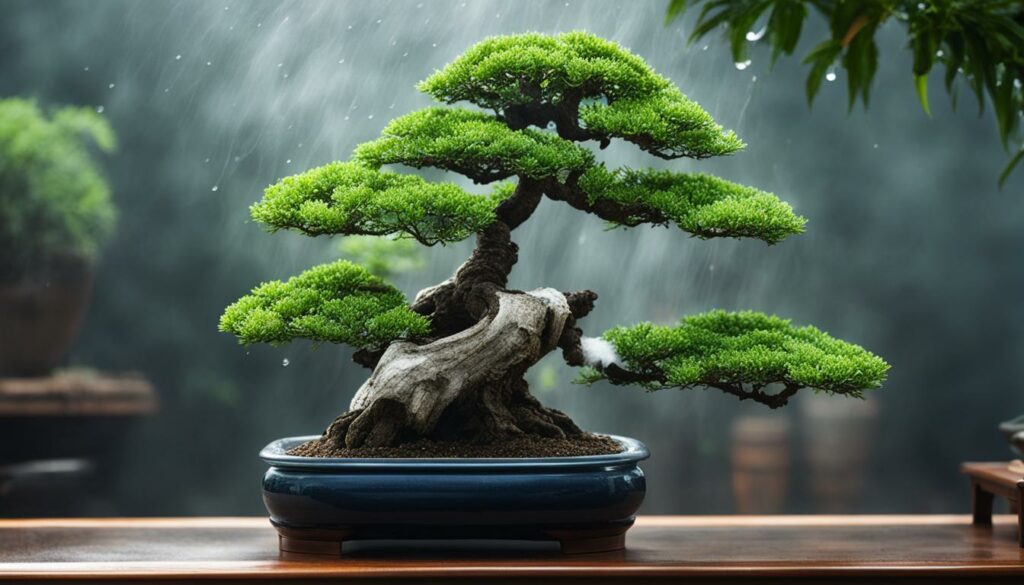
Your bonsai trees need humidity to thrive. However, it’s crucial to maintain a balance between humidity and airflow. Too much moisture can lead to mold and pest infestations, while too little moisture can cause leaf dryness and stress.
By implementing these methods, you can ensure that your bonsai will thrive in a healthy and balanced environment.
Promoting Airflow
Adequate airflow is essential in the cultivation of healthy bonsai trees. It helps prevent diseases and promotes growth. Here’s how you can optimize airflow by creating microclimates that minimize drafts and protect your bonsai trees from excessive wind exposure.
Choosing the Right Location
The location of your bonsai trees and the direction of airflow are important factors in creating a microclimate that promotes optimal growth. Position your trees in an open area without being exposed to strong winds that may damage them. Also, keep them away from areas that may obstruct air movement around the trees.
Spacing and Pruning Your Bonsai Trees
Properly spacing and pruning your trees can help promote healthy airflow and prevent the accumulation of dead or diseased foliage. Overcrowded trees can create a stagnant microclimate that encourages open wounds and rot. Keep your trees pruned to enhance their health and beauty.
Adding Bonsai Accessories
Consider adding accessories to improve airflow around your trees. Small electric fans can create an effective microclimate that channels fresh air to your trees. Installing windbreaks can also help protect your trees, preventing strong gusts from damaging them.
Monitoring Airflow
Regular monitoring of the air movement around your bonsai trees is essential to maintaining a healthy microclimate. Watch for signs of stagnant air, and if necessary, make adjustments to your pruning, spacing, or adding additional accessories to boost airflow.
Creating Protective Barriers
When it comes to bonsai cultivation, protecting your trees from harsh weather conditions, pests, and other external factors is essential. Here are some methods for creating protective barriers and shelters:
Row Covers
Row covers are a type of protective fabric that can shield your bonsai trees from frost, snow, and other extreme weather conditions. These covers trap heat and moisture, creating a miniature greenhouse environment to keep your trees warm and healthy. Simply drape the fabric over your bonsai and secure it to the ground with stakes or pins.
Pest Netting
Protecting your bonsai from pests can be a challenge, but using pest netting can be an effective solution. These mesh covers prevent insects, birds, and other animals from damaging your trees. Choose a netting material with small enough gaps to keep out the desired pests, while still allowing sunlight and moisture to penetrate.
Cold Frames
Cold frames are a simple way to create a microclimate that protects your bonsai from cold temperatures, wind, and frost. You can purchase a pre-made cold frame or build your own using materials such as PVC piping and clear plastic. These structures trap heat and moisture, providing a warm and sheltered environment for your trees.
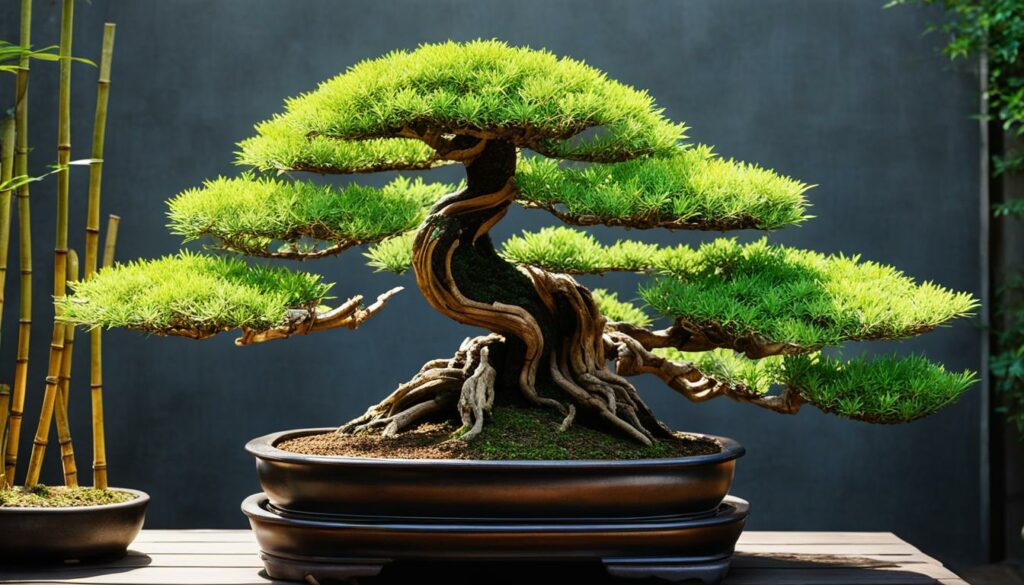
Note: Protective barriers and shelters should only be used when necessary and for short periods. Overuse of these structures can create an artificial microclimate that may harm your bonsai trees over time.
Creating protective barriers is just one aspect of optimizing your bonsai cultivation through microclimate control. In the next section, we will explore accessories that can enhance your microclimate strategy.
Incorporating Microclimate Accessories
Creating microclimates for bonsai cultivation requires careful attention to environmental control. To enhance your strategy, consider incorporating accessories such as:
- Shade cloths: Shields your bonsai from excess sunlight, reducing heat stress and dryness. Also helps to regulate temperature and prevent leaf scorching.
- Misting systems: Provides a fine mist of water to increase humidity levels around your bonsai. This can promote healthy foliage and protect against dehydration in dry weather.
- Fans: Promotes airflow around your bonsai, preventing stagnant air and mold growth. Also helps to reduce heat stress and humidity levels in humid weather.
- Heaters: Keeps your bonsai warm during colder months, preventing root damage and ensuring robust growth. Especially useful for tropical bonsai species that require high temperatures.
When selecting microclimate accessories, ensure that they are well-suited to the specific needs of your bonsai trees. Proper positioning and integration of accessories into your cultivation practices can help create and maintain optimal growing conditions for your collection.
“Accessories such as shade cloths, misting systems, fans, and heaters can be valuable tools in creating and maintaining microclimates. Discover how to integrate these accessories effectively into your bonsai cultivation practice.”
Monitoring and Adjusting Microclimates
Creating microclimates tailored to your bonsai’s unique needs is a continuous process that requires regular monitoring and adjustment. Weather patterns can change quickly, and your bonsai’s requirements can shift as it grows and develops. By staying attuned to these changes, you can ensure your microclimates are always optimized for optimal bonsai growth.
Here are some tips for monitoring and adjusting your microclimates:
1. Check Your Trees Regularly
Make it a habit to check your bonsai trees daily, particularly in the morning and evening. Look for signs of stress, such as wilted leaves or dry soil. Use a moisture meter to accurately assess soil moisture levels and adjust your watering schedule as needed.
2. Watch for Weather Changes
Monitor the local weather forecast and plan accordingly. In hot weather, you may need to provide extra shade or increase watering frequency. In cold weather, you may need to add heaters or protective covers to keep your trees warm.
3. Fine-Tune Your Microclimates
Regularly assess the effectiveness of your microclimates and make adjustments as needed. Consider factors like temperature, light, humidity, and airflow. Aim to create a harmonious balance that meets your bonsai’s unique needs.
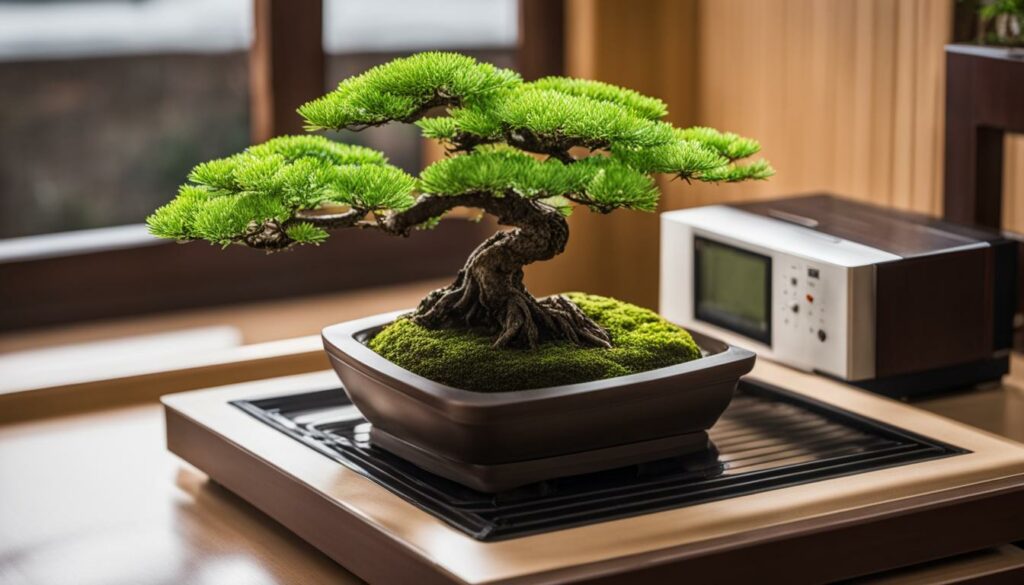
“Creating microclimates for bonsai cultivation requires time, patience, and attention to detail. But with the right environmental control and growing zone adaptation, your trees will thrive and flourish.”
Adapting for Different Bonsai Species
Each bonsai species has unique needs and preferences when it comes to creating microclimates for optimal growth. By understanding the growing zones and adapting to bonsai adaptation, you can ensure the best possible environment for your trees. Some species, like Japanese maple bonsai, prefer cooler temperatures and shade, while others, like Chinese elm, thrive in warmer, sunnier spots. Here are some factors to consider and techniques to use when creating microclimates according to species:
| Bonsai Species | Preferred Temperature Range | Preferred Light Conditions | Preferred Humidity Levels | Preferred Airflow Conditions |
|---|---|---|---|---|
| Japanese Maple | 50-70°F (10-21°C) | Partial shade to full sun | Moderate to high | Minimize exposure to strong winds |
| Chinese Elm | 60-85°F (16-29°C) | Full sun to partial shade | Moderate to high | Avoid stagnant air, protect from drafts |
| Juniper | 60-75°F (16-24°C) | Full sun to partial shade | Low to moderate | Provide good ventilation, avoid excessive exposure to wind |
- Consider grouping similar species together when creating microclimates to simplify maintenance and create optimal conditions for all
- Pay attention to the natural habitat and climate of the bonsai species you have, and try to replicate those conditions as closely as possible
- Experiment with different microclimate techniques and monitor the response of your trees to determine the optimal environment
- Adjust microclimates as needed based on seasonal changes or changes in the health and vitality of your trees
Extending the Growing Season
With the right microclimate strategies, you can extend the growing season for your bonsai trees beyond what is typically achievable in your location. These techniques also enable your trees to thrive, even during the colder months, or when the weather is unpredictable.
Protecting Your Trees During Cooler Months
The first step to extending the growing season is protecting your trees during the cooler months. One of the most effective approaches is to provide your bonsai with winter protection to keep them warm and sheltered from the harsh elements. This can include wrapping the pots in insulation or burlap, moving the trees indoors, or installing temporary shelters like cold frames or mini-greenhouses.
Pro Tip: Make sure to remove any frost before it melts to avoid disease or rot setting in.
Maximizing Growth During Warmer Months
During the warmer months, it’s crucial to ensure your trees are receiving an optimal amount of light and ventilation to encourage growth. Regular pruning and training can promote healthy branch development and lead to denser foliage. Bonsai-specific fertilizers can also aid in the development of strong roots and abundant growth.
However, excessive heat or prolonged drought can be detrimental to bonsai growth. To avoid heat stress, ensure your trees are well-shaded during the hottest hours of the day. Additionally, consider increasing the humidity levels and providing adequate ventilation to avoid heat-induced stress.
Preventing Blossom Loss
If your bonsai is prone to dropping blossoms prematurely, incorporating microclimate strategies such as misting or humidity trays can help prevent this issue. Blossom drop can also occur due to improper irrigation or fertilization, so make sure your trees are receiving adequate water and nutrients.
Troubleshooting Microclimate Issues
Despite your best efforts, issues with your microclimate may still occur. Here are some common problems that you might encounter while cultivating bonsai, along with tips for how to solve them:
Problem: Heat Stress
Heat stress can occur when a bonsai is exposed to high temperatures and insufficient water, causing the leaves to wither and dry out. To prevent heat stress, ensure that your bonsai is regularly watered and placed in a shaded or cool area. You can also add a layer of mulch around the base of the tree to help retain moisture.
Problem: Improper Lighting
Bonsai trees require the right amount of light to thrive, but too much or too little light can harm them. If your tree is receiving too much light, move it to a shadier location. If it’s not getting enough light, move it to a sunnier spot or consider investing in artificial lighting. Keep in mind that different bonsai species have different lighting needs.
Problem: Humidity Imbalances
Humidity imbalances can cause bonsai leaves to dry out or fungal growth to occur. To regulate humidity levels, mist your bonsai regularly or use a humidity tray. You can also group your bonsai together to create a more humid microclimate.
Problem: Airflow Problems
Insufficient airflow can prevent your bonsai from receiving enough oxygen and cause pest and disease problems. To promote airflow, prune your bonsai tree regularly and avoid placing it in an area with stagnant air. You can also use a fan to circulate air around your bonsai collection.
Problem: Root Rot
Root rot occurs when a bonsai tree is overwatered or has poor drainage, causing the roots to become waterlogged and rot. To prevent root rot, make sure your bonsai has adequate drainage and is planted in well-draining soil. Water only when the top layer of soil feels dry to the touch.
By troubleshooting and resolving these microclimate issues, you can maintain a healthy and thriving bonsai collection. Remember to regularly monitor your bonsai’s microclimate and make adjustments as needed.
Fine-Tuning Your Microclimate Strategy
Congratulations! You’ve now gained enough experience to fine-tune your microclimate strategy for optimal bonsai growth. The following are some guidance on how to continue improving and adapting your microclimate techniques:
- Observe your bonsai closely: Take note of how your bonsai is responding to its microclimate. Keep track of any changes or improvements in your plants to know what’s working and what’s not.
- Create a trial and error environment: Experiment with different strategies, from placement of the bonsai to accessories, to find out what works best in your environment. Don’t be afraid to make mistakes; they are opportunities to learn and refine your techniques.
- Stay up-to-date with weather patterns: Keep track of changes in the weather to make timely adjustments to your microclimate. For example, extreme weather conditions may require you to install protective barriers or heaters.
- Seek advice from experienced growers: Join bonsai cultivation groups or seek advice from experienced growers online or in-person. They may have valuable tips and insights that can help you improve your microclimate strategies.
Remember, the key to success in bonsai cultivation is patience, dedication, and continuous learning. Stay curious and open-minded as you fine-tune your microclimate strategy for even more robust bonsai growth!
Conclusion
Now that you have a solid understanding of microclimates and how they apply to bonsai cultivation, it’s time to put your knowledge into practice. Remember to assess your bonsai’s unique needs, choose the right location, and implement strategies for temperature control, light management, humidity enhancement, and airflow promotion.
Don’t be afraid to experiment with different techniques and accessories, and remember to monitor and adjust your microclimates regularly. With patience and persistence, you can create optimal growing conditions for your bonsai trees and enjoy the beauty and rewards of successful cultivation.
Whether you’re a seasoned bonsai enthusiast or just starting, the principles of microclimates are paramount in achieving the best possible results for your trees. By following the guidelines outlined in this article and adapting them to suit your specific bonsai species and growing zone, you can create a thriving bonsai collection that’s sure to impress.
FAQ
What are microclimates and why are they important for bonsai cultivation?
Microclimates refer to small-scale variations in the climate of a specific area, caused by factors such as sunlight, wind, temperature, and humidity. Creating microclimates is crucial for bonsai cultivation because it allows you to create optimal growing conditions for your trees that cater to their unique needs, ensuring robust growth and health.
How do I assess my bonsai’s needs when it comes to environmental factors?
Assessing your bonsai’s needs involves considering its species, growing zone, and overall health. Research the specific requirements for your bonsai species in terms of temperature, light, humidity, and airflow. Additionally, take into account the average conditions in your growing zone and any specific needs your tree may have based on its health and stage of growth.
What factors should I consider when choosing the location for my bonsai?
When selecting a location for your bonsai, consider factors such as sunlight exposure, wind protection, and proximity to buildings or natural barriers. Determine how much direct sunlight your bonsai requires and choose a location that provides the right amount. Shield your tree from strong winds that can cause dehydration or damage. Lastly, consider any existing structures or trees that can act as barriers against adverse weather conditions.
How can I control the temperature in my bonsai’s microclimate?
Temperature regulation is crucial for bonsai health and growth. You can control the temperature in your bonsai’s microclimate by placing it in a location that provides the desired temperature range, using shading techniques to protect it from excessive heat, and using insulation or heaters to maintain warmth during colder months.
How can I optimize light levels in my bonsai’s microclimate?
Optimizing light levels involves providing the right amount and quality of light for your bonsai tree. You can achieve this by positioning your tree in a location with the appropriate amount of sunlight exposure, using shading techniques to protect it from excessive light, and utilizing artificial lighting, if necessary, to supplement natural light.
What can I do to enhance humidity levels for my bonsai?
Enhancing humidity levels in your bonsai’s microclimate can be done through various methods. Misting the foliage regularly, using humidity trays filled with water to create a humid environment, and grouping bonsai trees together to increase humidity levels are effective ways to enhance humidity for your bonsai.
How can I promote adequate airflow in my bonsai’s microclimate?
Adequate airflow is essential for preventing diseases and promoting healthy growth in bonsai trees. To promote airflow, position your bonsai in an area with good air circulation, avoid placing it near drafty areas or fans, and trim excess foliage to allow air to move freely.
Are there any accessories I can use to create and maintain microclimates for my bonsai?
Yes, there are several accessories you can use to create and maintain microclimates for your bonsai. Shade cloths can help regulate light levels, misting systems aid in humidity control, fans can promote airflow, and heaters can provide warmth during colder months. Use these accessories strategically based on your bonsai’s needs and the climate in your area.
How can I monitor and adjust my bonsai’s microclimate?
Regular monitoring is essential to ensure optimal bonsai growth. Use thermometers, hygrometers, and light meters to assess temperature, humidity, and light levels in your bonsai’s microclimate. Based on this information, make adjustments as needed, such as moving your bonsai to a different location or modifying the use of shading or artificial lighting.
How do I adapt my microclimate strategy for different bonsai species?
Each bonsai species has its own requirements for temperature, light, humidity, and airflow. Research the specific needs of your bonsai species and adjust your microclimate strategy accordingly. Factors such as growing zone and the natural habitat of the bonsai species should also be taken into account when creating its microclimate.
Can microclimates help me extend the growing season for my bonsai?
Yes, creating the right microclimate can help you extend the growing season for your bonsai trees. By protecting your trees from cold temperatures during the winter and maximizing growth conditions during the warmer months, you can effectively extend the season and promote continuous growth and development.
What are some common microclimate issues in bonsai cultivation, and how can I troubleshoot them?
Common microclimate issues in bonsai cultivation include heat stress, improper lighting, humidity imbalances, and airflow problems. To troubleshoot these issues, assess the conditions in your bonsai’s microclimate and make adjustments accordingly. For example, if your bonsai is experiencing heat stress, provide more shade or improve ventilation to lower the temperature.
How can I continually improve and adapt my microclimate techniques for optimal bonsai growth?
Continual improvement and adaptation of microclimate techniques can be achieved through observation and experimentation. Observe the performance of your bonsai trees and make notes of any areas for improvement. Experiment with different strategies and assess the results. Over time, you’ll develop a more refined and effective microclimate technique for your bonsai collection.
